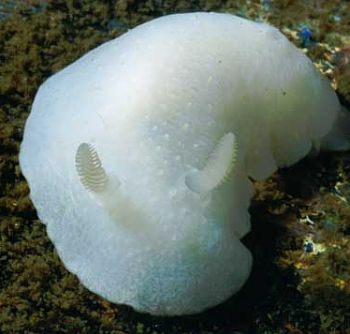
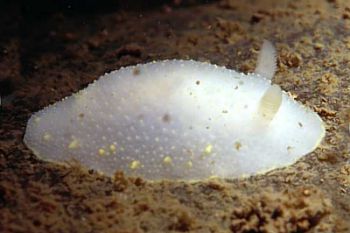
Cadlina laevis
Linnaeus, 1767
Order: NUDIBRANCHIA
Suborder: DORIDINA
Superfamily: EUDORIDOIDEA
Family: Chromodorididae
DISTRIBUTION
Arctic and North Atlantic from intertidal to 800m. Spitzbergen & White Sea, Iceland, Greenland, and on the European coast from Norway to northern Spain. On North American coast south to Massachusetts.
PHOTO
UPPER: Near the wreck of the little concrete yacht at Ballachulish, Loch Leven, west coast, Scotland. 12 metres, 32mm long. 13 May, 2001. LOWER: Avon Rock in the Sound of Mull, Scotland. 16 metres, 24mm long. June 1995. PHOTOS: Jim Anderson. [Scottish Nudibranchs]
Usually white, sometimes with a number of milky yellow glands on the mantle skirt. In rare cases the edge, or the whole mantle is tinged with yellow. It feeds on encrusting slime sponges, in particular Halisarca dujardini. It appears to be a winter breeder, the eggs hatching in about 50 days as small crawling slugs, with no planktonic larval stage.
• See also Bernard Picton's message about colour 'forms'.
• See Cadlina cf. luteomarginata from Nth America.
References:
• Bleakney, J.S., (1996) Sea Slugs of Atlantic Canada and the Gulf of Maine
• Thompson, T.E. & Brown, G.H. (1984) Biology of Opisthobranch Molluscs, Vol 2. Ray Society: London.
Rudman, W.B., 2001 (July 4) Cadlina laevis Linnaeus, 1767. [In] Sea Slug Forum. Australian Museum, Sydney. Available from http://www.seaslugforum.net/find/cadllaev
Related messages
Cadlina laevis from France
June 29, 2006
From: Wilfried Bay-Nouailhat
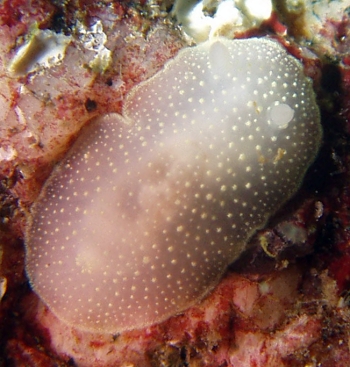
Dear Bill,
We've seen several specimens of this nudibranch. After a search in Sea Slug Forum, I think that it could be Cadlina laevis. Can you give me your opinion about it?
Locality: Laon Ejen Hir, Iles Glénan, Finistère Sud, 14 m, France, Atlantic Ocean, 18 June 2006, On rocks, . Length: 20 mm. Photographer: Wilfried Bay-Nouailhat.
Best wishes
Anne and Wilfried Bay-Nouailhat
contact@mer-littoral.org
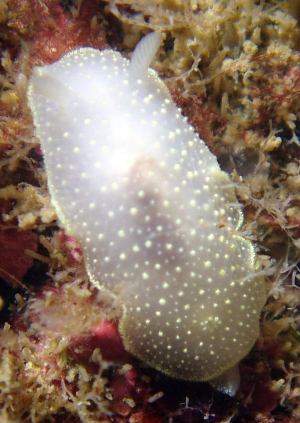
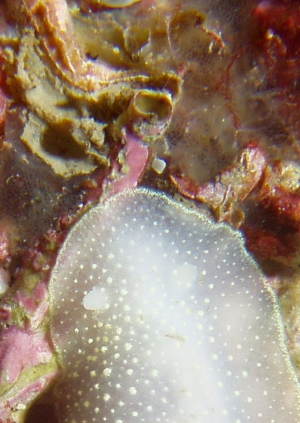
Dear Willy,
Yes this is Cadlina laevis. You will see from Bernard Picton's message [#4793 ] that there seem to be two colour 'forms' of this species, one with bright yellow spots and mantle border, and the other without.Yours, with pale milky yellow spots seems to be an intermediate form. Bernard notes that the yellow-spotted form usually eats the sponge Dysidea fragilis and lives sublittorally, while the other form feeds on Halisarca and lives intertidally. Interestingly, in one of your photos [lower right] there is a greyish sponge which could well be Dysidea, the food of the yellow-spotted form.
Best wishes,
Bill Rudman
Cadlina sp from Portugal
September 6, 2005
From: Miguel Macedo
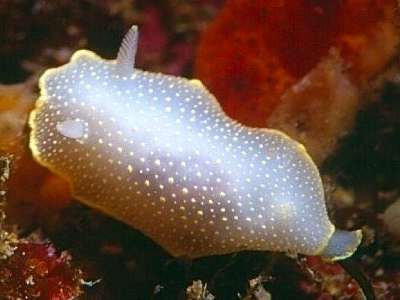
Dear Bill,
I ask your help to identify this nudibranch, photographe last June in the Portuguese west coast (Northeast Atlantic Ocean), in Berlenga Island near the towns Peniche and Baleal, north of Lisbonne.
Locality: Berlenga Island (near Peniche and Baleal), Portugal, NE Atlantic Ocean. Depth: 20 meters. Length: 1,5 cm 25 June 2005. Photographer: Miguel Macedo
Thank You, Best Regards,
Miguel Macedo
migmac@netcabo.pt
Macedo, M, 2005 (Sep 6) Cadlina sp from Portugal. [Message in] Sea Slug Forum. Australian Museum, Sydney. Available from http://www.seaslugforum.net/find/14712Dear Miguel,
This is a species of Cadlina. At present only Cadlina laevis is supposed to occur in the NE Atlantic and it usually does not have any yellow markings. But as Bernard Picton and I have discussed [see message #4793] it is possible that there is more than one species involved. As I mentioned earlier, this yellow-bordered animal is probably the 'form' of C. laevis which was reported from southern England to the Mediterranean by Bouchet & Moreteau (1976) who suggest it may be a distinct species. It would be nice to know something about its anatomy and biology, especially what sponge it feeds on and what its eggs look like.
So all I can say is it may be a from of Cadlina laevis, or it may be an unnamed species of Cadlina. We just don't know. There is also a similar problem about what to call the Cadlina on the NW Atlantic coast of North America
-
Bouchet, P. & Moreteau, J.C. (1976) Additions a l'inventaire des Molusques de Roscoff: Gasteropodes Opisthobranches. Trav. Stat. biol. Roscoff, 23: 1-8.
Best wishes,
Bill Rudman
Cadlina laevis from Scotland
July 9, 2001
From: Jim Anderson


Dear Bill,
As a follow-up to Paul Young's Cadlina from North America, here are two photos from my website [Scottish Nudibranchs] to illustrate some of the colour variety in European Cadlina laevis
UPPER: June 1995. Avon Rock in the Sound of Mull, Scotland. 16 metres, 24mm long.
LOWER: 13 May, 2001. Near the wreck of the little concrete yacht at Ballachulish, Loch Leven on the west coast. Water temperature 9 deg C at 12 metres, a 32mm animal. Several were seen at different places on this site, all in the 6 - 15 metre range. PHOTOS: Jim Anderson.
Best wishes,
Jim.
jander4454@aol.com
Anderson, J., 2001 (Jul 9) Cadlina laevis from Scotland. [Message in] Sea Slug Forum. Australian Museum, Sydney. Available from http://www.seaslugforum.net/find/4784Thanks Jim,
It seems something as 'well-known' as Cadlina laevis may in fact need a closer look. With direct development I guess 'regional' colour varieties could evolve but it looks like it could benefit from a comparative study. Since Paul's Nth American animal appears to feed on Halisarca it would be very interesting to know if its eggs are large, which would indicate that it too has direct developing larvae.
Cheers,
Bill Rudman
Cadlina laevis & C. cf. luteomarginata
July 9, 2001
From: Bernard Picton
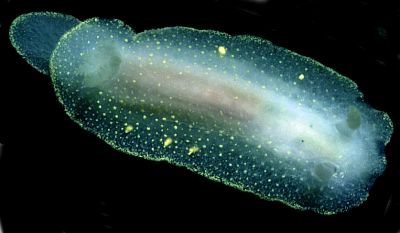
Hi Bill,
I see the recent correspondence on Cadlina from the NW Atlantic. Here in the NE Atlantic we are only supposed to have Cadlina laevis, but in my experience there seem to be two colour forms. In Scotland they seem to be more intertidal and feed on the sponge Halisarca dujardini (which looks just like Paul Young's sponge incidentally) and they are milky white in colour. On the west coast of Ireland where it is warmer they have many small yellow spots and a thin yellow margin like Paul Young's animal but feed on Dysidea fragilis primarily and live mostly in the sublittoral. Cadlina laevis has direct development and this variation has always been ascribed to the fact that with no planktonic dispersal there is probably a clinal variation in Cadlina laevis. The two forms don't seem to occur together so this is possible. Again I think the DNA or Enzyme experts need to look at this!
UPPER RIGHT: - Nov 1979 - Malin Beg, Co Donegal, Ireland
LOWER LEFT: - July 1981 - Westmann Islands, Iceland
LOWER RIGHT: - July 1991 - Loch Etive, W. Scotland
Bernard
bernard.picton.um@nics.gov.uk
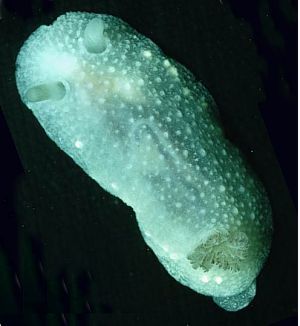
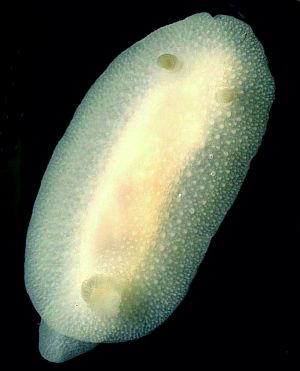
Dear Bernard,
Your message is a nice supplement to Jim Anderson's photos, though as you suggest the identity of these Cadlina is unresolved. Unless Cadlina laevis can happily feed on both Dysidea and Halisarca it seems there may be more than one species present. Perhaps the yellow bordered 'form' from Ireland is the 'form' of C. laevis reported from southern England to the Mediterranean that Bouchet & Moreteau (1976) suggest may be a distinct species. Do we know that all the colour forms have direct development? Before the chemists are called in, perhaps it would be worth correlating food, radular morphology and development type with colour form - though perhaps this has already been done?
• Bouchet, P. & Moreteau, J.C. (1976) Additions a l'inventaire des Molusques de Roscoff: Gasteropodes Opisthobranches. Trav. Stat. biol. Roscoff, 23: 1-8.
Cheers,
Bill Rudman
